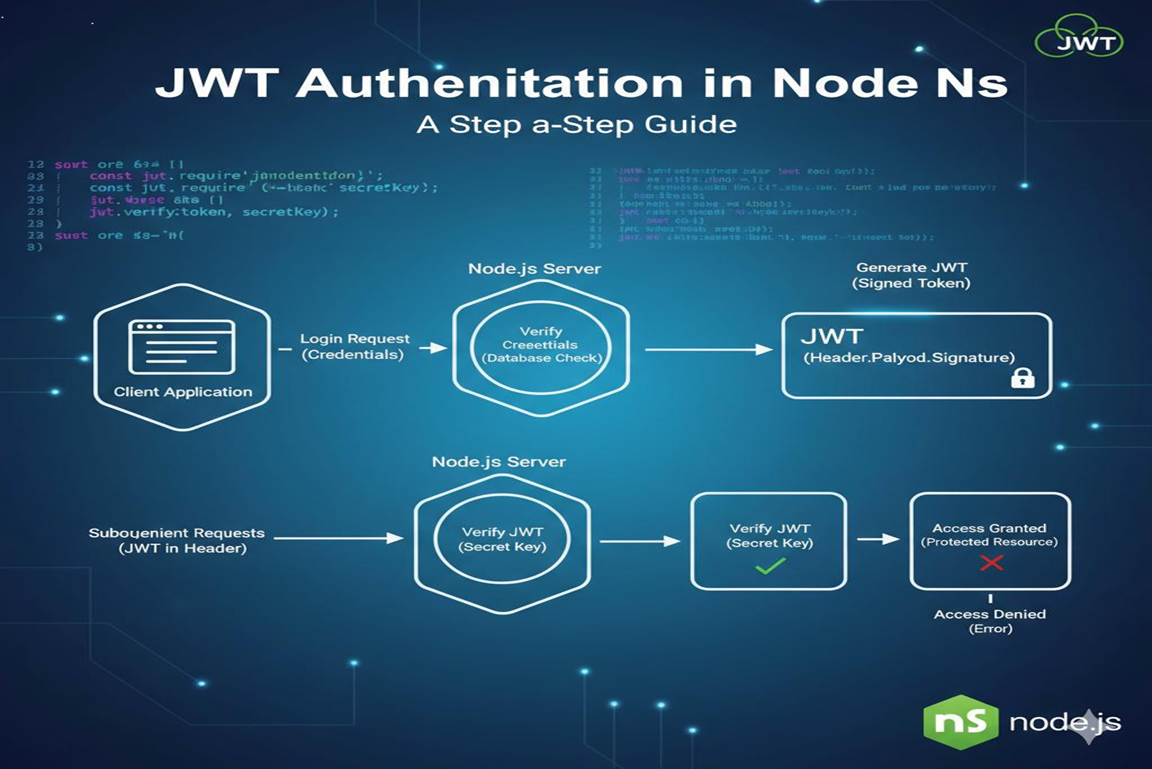
How a BDE Connects Business Vision With Technology
How a BDE Connects Business Vision With Technology Kumkum Kumari 21/11/2025At Speqto, we work with organizations that are constantly evolving entering new markets, scaling operations, or […]


JSON Web Tokens (JWT) are a widely-used method for securely transmitting information between parties as a JSON object. In Node.js applications, JWT is commonly used for user authentication and authorization. This guide will walk you through implementing JWT authentication in a Node.js application step by step.
JWT allows you to create stateless authentication systems, meaning the server does not need to store session information. It’s secure, scalable, and works seamlessly with APIs. By using JWT, you can protect routes, verify users, and ensure secure communication between client and server.
First, create a new project folder and initialize it:
mkdir jwt-auth-demo
cd jwt-auth-demo
npm init -yInstall the necessary packages:
npm install express jsonwebtoken bcryptjs body-parser– express – For creating the server.
– jsonwebtoken – For generating and verifying JWTs.
– bcryptjs – For hashing passwords.
– body-parser – For parsing incoming request bodies.
Create a file server.js:
const express = require('express');
const bodyParser = require('body-parser');
const app = express();
app.use(bodyParser.json());
app.get('/', (req, res) => {
res.send('JWT Authentication Demo');
});
app.listen(3000, () => {
console.log('Server running on http://localhost:3000');
});In a real application, you’d store users in a database. For simplicity, we’ll use an in-memory array:
const users = [];
const bcrypt = require('bcryptjs');
app.post('/register', async (req, res) => {
const { username, password } = req.body;
const hashedPassword = await bcrypt.hash(password, 10);
users.push({ username, password: hashedPassword });
res.send('User registered successfully!');
});This hashes the user’s password before storing it, ensuring security.
const jwt = require('jsonwebtoken');
app.post('/login', async (req, res) => {
const { username, password } = req.body;
const user = users.find(u => u.username === username);
if (!user) return res.status(400).send('User not found');
const isMatch = await bcrypt.compare(password, user.password);
if (!isMatch) return res.status(400).send('Invalid credentials');
const token = jwt.sign({ username: user.username }, 'your-secret-key', { expiresIn: '1h' });
res.json({ token });
});This generates a JWT token that expires in 1 hour.
const authenticate = (req, res, next) => {
const token = req.header('Authorization')?.replace('Bearer ', '');
if (!token) return res.status(401).send('Access denied');
try {
const verified = jwt.verify(token, 'your-secret-key');
req.user = verified;
next();
} catch (err) {
res.status(400).send('Invalid token');
}
};
app.get('/protected', authenticate, (req, res) => {
res.send('This is a protected route. Welcome ' + req.user.username);
});Now, only users with a valid JWT can access the protected route.
Implementing JWT authentication allows you to create secure, stateless authentication for your Node.js applications. This approach can be extended to APIs, microservices, and frontend-backend integrations, giving you full control over user access and authorization.
JWT authentication in Node.js is powerful and straightforward. By following these steps—setting up the project, registering users, generating tokens, and protecting routes—you can secure your application efficiently. Once comfortable, you can integrate databases, refresh tokens, and more advanced authentication features to build robust and scalable applications.

How a BDE Connects Business Vision With Technology
How a BDE Connects Business Vision With Technology Kumkum Kumari 21/11/2025At Speqto, we work with organizations that are constantly evolving entering new markets, scaling operations, or […]

Apache JMeter Demystified: Your 7-Stage Blueprint for a Seamless First Performance Test
Apache JMeter Demystified: Your 7-Stage Blueprint for a Seamless First Performance Test Megha Srivastava 21 November 2025 In the intricate world of software development and deployment, ensuring a robust user experience is paramount. A slow application can quickly deter users, impacting reputation and revenue. This is where Apache JMeter emerges as an indispensable tool, offering […]

STRIDE Simplified: A Hands-On Blueprint for Pinpointing Software Threats Effectively
STRIDE Simplified: A Hands-On Blueprint for Pinpointing Software Threats Effectively Megha Srivastava 21 November 2025 In the intricate landscape of modern software development, proactive security measures are paramount. While reactive incident response is crucial, preventing vulnerabilities before they become exploits is the hallmark of robust software engineering. This is where threat modeling, and specifically the […]

From Static to Streaming: A Practical Developer’s Guide to Real-time Applications Using GraphQL Subscriptions
From Static to Streaming: A Practical Developer’s Guide to Real-time Applications Using GraphQL Subscriptions Shakir Khan 21 November 2025 The Paradigm Shift: From Static to Streaming Experiences In an era where user expectations demand instant gratification, the web has rapidly evolved beyond its static origins. Today, a modern application’s success is often measured by its […]

The TanStack Query Edge: Deep Dive into Advanced Caching for Optimal Application Speed
The TanStack Query Edge: Deep Dive into Advanced Caching for Optimal Application Speed Shubham Anand 21 November 2025 In the relentless pursuit of seamless user experiences and lightning-fast web applications, data management stands as a formidable challenge. Modern front-end frameworks demand intelligent solutions to handle asynchronous data, and this is precisely where TanStack Query (formerly […]